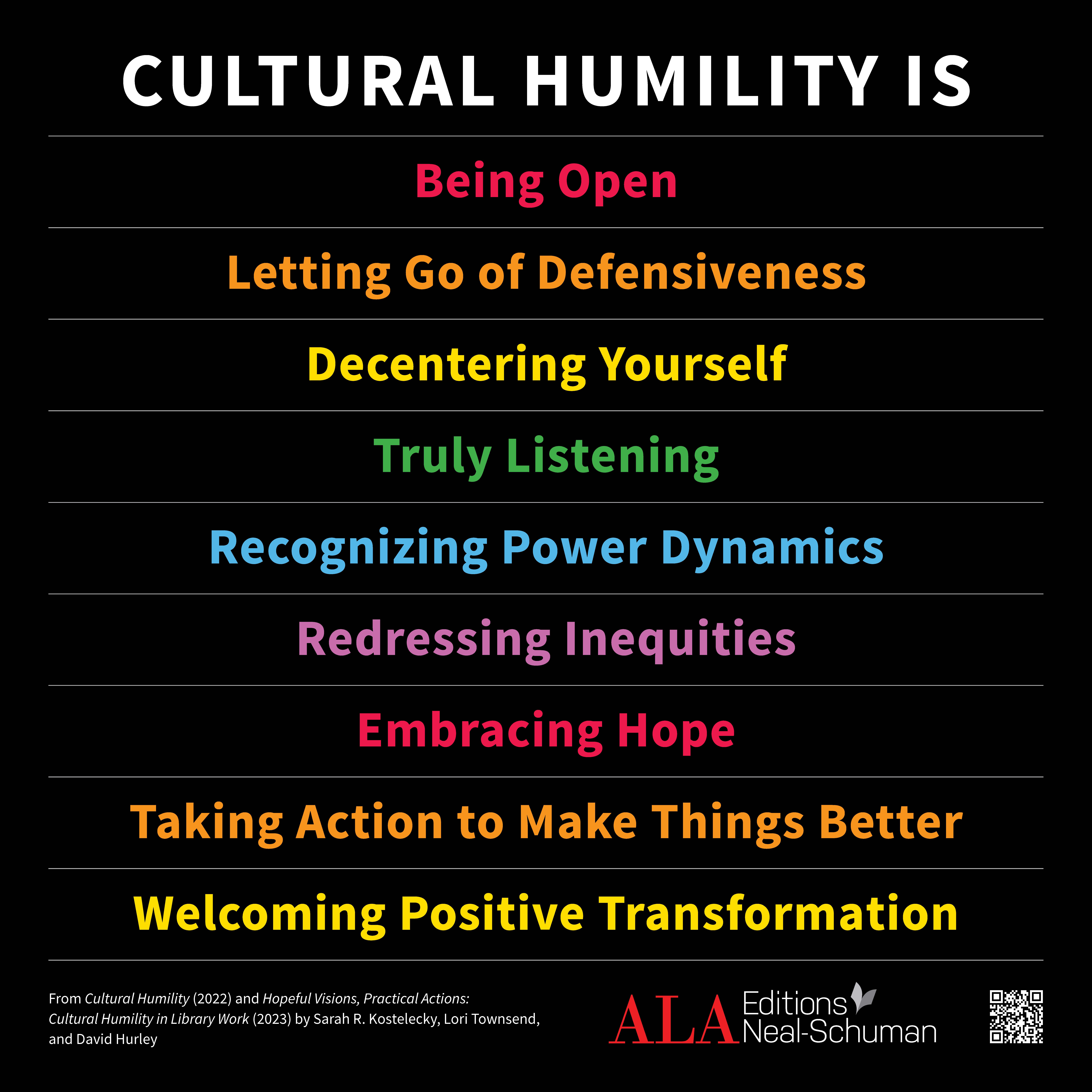Cultural Humility: Elements of Practice
a guest post by Sarah R. Kostelecky, Lori Townsend, and David A. Hurley
When we started putting the book Hopeful Visions, Practical Actions: Cultural Humility in Library Work together, it was great to see all the different ways people are using cultural humility in libraries. Now that the book is out, it has been an unexpected joy to see what resonates the most with different people. One of the first responses came from the fabulous team at ALA Editions. They created a poster on cultural humility that will be available at the 2023 ALA Annual Conference & Exhibition based on themes from the book. The poster shares some elements of a practice of cultural humility. This is the first of two blog posts where we’ll share a bit more about what's on the poster.
 Cultural humility is an approach to equity, diversity, and inclusion (EDI) that helps us recognize and redress structural issues and power differentials that interfere with providing good library service to all. At its core, it is an approach to making change — to see where change is needed, and then take action to improve services, improve the workplace, and improve relationships. Using a cultural humility lens takes effort and can be difficult and uncomfortable. It can also be an opportunity to find joy and appreciation in our work, our colleagues, and in the continuation of lifelong learning.
Cultural humility is an approach to equity, diversity, and inclusion (EDI) that helps us recognize and redress structural issues and power differentials that interfere with providing good library service to all. At its core, it is an approach to making change — to see where change is needed, and then take action to improve services, improve the workplace, and improve relationships. Using a cultural humility lens takes effort and can be difficult and uncomfortable. It can also be an opportunity to find joy and appreciation in our work, our colleagues, and in the continuation of lifelong learning.
Cultural humility is Being Open
Being open to new ideas and different perspectives reminds us that our norms are not universal. By listening to and appreciating the experiences of others, we may be more accepting in realizing when our current understandings are wrong – and work to learn new ones. As library workers, we’re well situated for this because we’re surrounded by materials that share stories and experiences that are different from our own! We can find joy in the process of learning about the history and culture of others, celebrating the many ways people experience the world and share it with us.
Cultural Humility is Letting Go of Defensiveness
This might be the hardest part of practicing cultural humility. It doesn’t mean we accept every criticism as true. A person may be upset with good reason, but lash out at our work, our library, or our motivations in ways that seem unfair. If we become defensive, we might wind up arguing about that, making the conversation about us. Instead, we can take a deep breath, and listen. Take the time to understand what the problem is for the other person, without needing to explain our side. We can reflect later on what might have triggered our defenses.
Cultural Humility is Decentering Yourself
Decentering doesn’t mean devaluing: you are unique and valuable! By decentering ourselves, we allow ourselves to also recognize and appreciate the unique and valuable person in front of us. Placing someone else at the center of our attention for a time can help us step outside of our own cultural norms. This means we can listen better, offer better service to our patrons, and be better partners for those working with us.
Cultural Humility is Truly Listening
When interacting with someone using a cultural humility approach, we want to be other oriented. We can do this with active listening skills, which encourage us to listen and leave our own emotions and reactions aside. This means fully focusing, not half listening while simultaneously planning our response.
 When we actively listen, it also reinforces another element of cultural humility: we cannot know everything and shouldn’t expect to. If we assume we know the other person needs before they tell us, we can miss what they are actually trying to communicate.
When we actively listen, it also reinforces another element of cultural humility: we cannot know everything and shouldn’t expect to. If we assume we know the other person needs before they tell us, we can miss what they are actually trying to communicate.
Cultural Humility Is Recognizing Power Dynamics
Sometimes power dynamics are obvious, like when a young student is asking their school librarian for help. Sometimes they are more complicated, like when the City Councilor’s spouse is asking a circulation clerk about reserving a meeting room. But, as the medical profession has long known, if left unchecked, power differentials can lead to negative outcomes. Practicing cultural humility involves staying vigilant for how power might be affecting an interaction, keeping in mind the ways our power is limited is often much more salient than the ways we have relative power.
We see cultural humility as an approach to making change while reducing harm. It gives some practical techniques for working with each other. It also involves making a commitment to take action and work to make things better. But cultural humility isn’t a cure-all nor is it the only approach to making change. In the second blog post, we’ll finish annotating the elements on the poster, and also talk about a couple of bonus elements that weren’t included on the poster.
Read Part Two of this blog post series and learn more at the ALA Store
